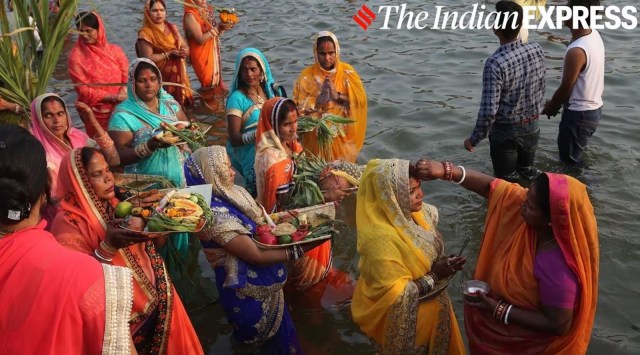📣 For more lifestyle news, click here to join our WhatsApp Channel and also follow us on Instagram
When is Chhath Puja 2023? Date, history, importance, significance
Chhath Puja 2023 Date in India: Chhath Puja is celebrated over four days, with its main rituals observed on the third day.
 Chhath Puja 2024: The festival is observed over four days, during which devotees perform elaborate ceremonies to honour the Sun God, seeking his blessings for health, prosperity, and the well-being of their family. (file)
Chhath Puja 2024: The festival is observed over four days, during which devotees perform elaborate ceremonies to honour the Sun God, seeking his blessings for health, prosperity, and the well-being of their family. (file) Chhath Puja 2023 Date in India: Chhath Puja, one of the most ancient and revered festivals in India, is a celebration of the sun god and nature. Observed primarily in the states of Bihar, Jharkhand, Uttar Pradesh, and the Terai region of Nepal, this festival is a grand occasion for worship, rituals, and devotion to the cosmic source of energy, the sun.
Chhath Puja in 2023: The Date
Chhath Puja is celebrated over four days, with its main rituals observed on the third day. In 2023, Chhath Puja will commence on Friday, 17th November, and the main day of worship, known as “Kharna,” will fall on Monday, 20th November. Devotees will gather by the rivers, ponds, and water bodies to offer their prayers to the setting sun.
Historical Roots of Chhath Puja
The history of Chhath Puja can be traced back to ancient Vedic texts, making it one of the oldest festivals in India. It is believed that Chhath Puja has been celebrated for more than 2,000 years. The word “Chhath” originates from the Sanskrit word “Shashthi,” which means the sixth day, indicating that the festival is celebrated on the sixth day of the lunar month after Diwali.
Importance of Chhath Puja
Worshipping the Sun God: Chhath Puja is dedicated to the worship of the sun god, Surya. The sun is considered the source of life and energy, and devotees offer their prayers to seek blessings for the well-being of their families.
Harvest Festival: Chhath Puja also holds significance as a harvest festival. It is celebrated during the post-harvest season when farmers express gratitude to the sun for a bountiful harvest and pray for the fertility of their lands.
Spiritual Significance: Chhath Puja is regarded as a spiritually purifying festival. Devotees observe rigorous fasts and offer their prayers to the sun at sunrise and sunset. This is believed to cleanse the mind and body and bring prosperity.
Community Bonding: Chhath Puja is a community-driven festival, emphasizing unity and social bonding. Families and neighborhoods come together to perform the rituals and offer collective prayers.
Significance of Chhath Rituals
Nahay Khay: The first day involves devotees taking a dip in a holy river or pond, followed by a meal of kaddu (pumpkin) and arwa (rice).
Lohanda and Kharna: On the second day, devotees observe a strict fast, and in the evening, they prepare a special prasad (offering) consisting of jaggery, thekua (a sweet snack), and fruits.
Sandhya Arghya: The third day is the most crucial. Devotees gather at the riverbanks before sunrise and offer ‘Arghya’ to the rising sun. They break their fast after this ritual.
Usha Arghya: On the final day, the same ritual of offering ‘Arghya’ is performed at sunset.
📣 For more lifestyle news, follow us on Instagram | Twitter | Facebook and don’t miss out on the latest updates!
📣 For more lifestyle news, click here to join our WhatsApp Channel and also follow us on Instagram
Photos


- 01
- 02
- 03
- 04
- 05
























